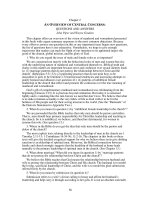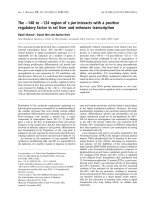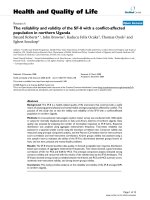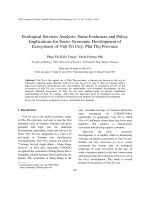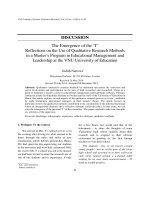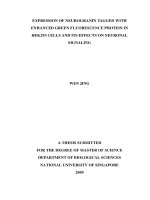Access to general education of students from ethnic minority groups with a very small population in lai chau and policy implications
Bạn đang xem bản rút gọn của tài liệu. Xem và tải ngay bản đầy đủ của tài liệu tại đây (931.26 KB, 69 trang )
VIETNAM NATIONAL UNIVERSITY, HANOI
VIETNAM JAPAN UNIVERSITY
HOANG THANH LICH
ACCESS TO GENERAL EDUCATION OF
STUDENTS FROM ETHNIC MINORITY
GROUPS WITH A VERY SMALL
POPULATION IN LAI CHAU AND
POLICY IMPLICATIONS
MASTER'S THESIS
VIETNAM NATIONAL UNIVERSITY, HANOI
VIETNAM JAPAN UNIVERSITY
HOANG THANH LICH
ACCESS TO GENERAL EDUCATION OF
STUDENTS FROM ETHNIC MINORITY
GROUPS WITH A VERY SMALL
POPULATION IN LAI CHAU AND
POLICY IMPLICATIONS
MAJOR: Public Policy
CODE: 8340402.01
RESEARCH SUPERVISOR:
Associate Prof. Dr. NGUYEN VAN CHIEU
Hanoi, 2021
ACKNOWLEDGMENT
Foremost, I would like to express my appreciation and sincere thanks to my
supervisor, Associate Prof. Dr. Nguyen Van Chieu. His patient and constructive advice
had helped me a lot in the completion of this thesis.
Special thanks to all professors from Master’s program in Public Policy, and
Ms. Pham Thi Lan Huong for their patience and continuous support.
My appreciation goes to the teachers, education administrators, the local official,
social workers, and the Mang people living in Huoi Cuong village (Lai Chau province)
who participated in the in-depth interviews. Their honest and cooperative answers
have provided useful information for my analysis.
Last but not least, I would like to express my love and great gratitude towards
my beloved family members and my friends for their encouragement and support.
Hanoi 19 June 2021,
Sincerely,
Hoang Thanh Lich
TABLE OF CONTENT
LIST OF TABLES .................................................................................................................... i
LIST OF FIGURES ................................................................................................................. ii
LIST OF ABBREVIATIONS ................................................................................................ iii
INTRODUCTION ....................................................................................................................1
1. Rationale ..................................................................................................................1
2. Literature review ......................................................................................................2
3. Research purpose .....................................................................................................8
4. Research questions ...................................................................................................8
5. Research scope and time .......................................................................................... 8
6. Methodology ............................................................................................................9
7. Research significance ............................................................................................. 10
8. Structure of the research......................................................................................... 10
CHAPTER 1: THEORETICAL FRAMEWORK ................................................................ 12
1.1. Ethnic minorities and VSEMs.............................................................................12
1.1.1. Ethnic minorities ........................................................................................... 12
1.1.2. Very small ethnic minorities .........................................................................14
1.2. General education and access to general education ............................................14
CHAPTER 2: THE CURRENT STATUS OF ACCESSING GENERAL EDUCATION
OF STUDENTS OF VSEMS IN LAI CHAU PROVINCE ................................................ 19
2.1. An overview of natural, socio-economic conditions and VSEMs in Lai Chau
province ......................................................................................................................19
2.1.1. An overview of natural, socio-economic conditions in Lai Chau province .19
2.1.2. An overview of VSEMs in Lai Chau province ..............................................21
2.2. General education for students of VSEMs in Lai Chau province ....................... 23
2.2.1. Schools and village-based school points ......................................................23
3.3.2. Teachers ........................................................................................................25
2.2.3. Distance between home and general education institutions ........................ 27
2.2.4. Policies on general education ......................................................................28
2.3. Access to general education of students of VSEMs in Lai Chau province ........29
CHAPTER 3: DIFFICULTIES IN ACCESSING GENERAL EDUCATION OF
STUDENTS OF VSEMS IN LAI CHAU PROVINCE ....................................................... 32
3.1. Natural conditions, and socio-economic development level of VSEMs in Lai
Chau province ............................................................................................................32
3.1.1. Natural conditions .......................................................................................... 32
3.1.2. Socio-economic conditions ...........................................................................33
3.2. Accessibility and acceptability............................................................................35
3.2.1. Limitations in general education policy for students of VSEMs ..................35
3.2.2. Distance to schools ....................................................................................... 37
3.3. Availability..........................................................................................................38
3.3.1. School facilities ............................................................................................. 38
3.3.2. Human resources .......................................................................................... 39
3.4. Adaptability .........................................................................................................40
3.4.1. The perception of VSEMs about the value of general education .................40
3.4.2. Language ......................................................................................................41
3.4.3. Outdated practices, the problem of child marriage .....................................42
CHAPTER 4: POLICY IMPLICATIONS FOR BETTERING ACCESS TO GENERAL
EDUCATION OF STUDENTS OF VSEMS IN LAI CHAU ............................................. 44
4.1. Strengthening awareness of the importance of education for VSEMs in Lai
Chau ........................................................................................................................... 44
4.2. Completing the policy on supporting general education for students of VSEMs
....................................................................................................................................45
4.3. Developing policies on human resources in general education for very small
ethnic minorities in Lai Chau province ......................................................................46
CONCLUSION ...................................................................................................................... 48
REFERENCES ....................................................................................................................... 50
APPENDIX ............................................................................................................................ 56
LIST OF TABLES
Table 2.1. The number of households of VSEMs in Lai Chau.................................... 21
Table 2.2. Number of schools in Lai Chau province in 2019 .......................................23
Table 2.3. Number of schools in VSEMAs in Lai Chau province in 2019 ..................24
Table 2.4. Number of village-based school points in Lai Chau province in 2019 .......24
Table 2.5. Number of village-based school points in VSEMAs in Lai Chau province in
2019 ............................................................................................................................... 25
Table 2.6. Number of teachers in Lai Chau province in 2019 ......................................25
Table 2.7. Number of teachers in VSEMAs in Lai Chau province in 2019 .................26
Table 2.8. Number of ethnic minority teachers in VSEMAs in Lai Chau province in
2019 ............................................................................................................................... 26
Table 2.9. Distance between home and general education institutions in 2015 ...........27
Table 2.10. Distance between home and general education institutions in 2019 .........28
Table 2.11. Percentage of students of VSEMs of school age at general education
institutions in Lai Chau province in 2015 .....................................................................29
Table 2.12. Percentage of students of VSEMs of school age at general education
institutions in Lai Chau province in 2019 .....................................................................30
Table 3.1. The percentage of poor households of VSEMs in Lai Chau in 2018 ..........34
Table 3.2. The percentage of child married ethnic people in VSEMAs in Lai Chau in
2018 ............................................................................................................................... 42
i
LIST OF FIGURES
Figure 3.1. The average distance from home to the nearest upper secondary school
among VSEMs in Lai Chau province ............................................................................37
ii
LIST OF ABBREVIATIONS
VSEMs: Very small ethnic minorities
VSEMAs: Very small ethnic minority areas.
iii
INTRODUCTION
1. Rationale
In recent years, sustainable development has been a research topic that has
received the attention of many researchers and policymakers in many parts of the
world. One of the sustainable development goals is quality education. Education is not
only a fundamental human right but also a sector of development playing a crucial role
in socio-economic growth, poverty alleviation, democratization, cultural tradition,
inheritance, and intercultural understanding (Kazuo, 2012).
Vietnam is a multi-ethnic nation that consists of 54 ethnic groups. The Kinh is
the majority ethnic group. The remaining 53 ethnic groups, accounting for 14.7% of
the population, are residing in 51 provinces and cities (General Statistics Office, 2020).
Notably, there are 16 VSEMs, mainly settling in 12 provinces across the country.
These VSEMs live in remote and mountainous regions where geographical conditions
are exceedingly harsh. Due to historical causes, and difficult natural conditions,
VSEMs are in the state of poverty. They are facing hardships in various aspects of
their lives and cannot develop by themselves. The school dropout rates of students of
VSEMs are high. In addition, there are many problems in ensuring quality education
for students of VSEMs. Many lower-secondary students could not speak properly Kinh
(Vietnamese) which is the official language used in schools and other educational
institutions. Therefore, the government needs to create better access to education for
students of VSEMs. It is explicitly clear that they need more time, and support from
the government to get quality education.
In spite of the fact that many researchers have carried out studies on quality
education, the research topic of access to general education of students of VSEMs in
Vietnam has not received attention. Therefore, this study will focus on clarifying the
current status of access to general education, identifying difficulties encountered by
students of VSEMs in accessing general education and proposing some policy
implications for bettering access to general education of students of VSEMs in Lai
Chau, Vietnam.
1
2. Literature review
Firstly, studies on ethnic minorities in Vietnam
Studies on ethnic minorities have been conducted by a plethora of researchers
from various aspects and angles. Many studies have described the economic life,
socio-cultural characteristics of ethnic minorities in Vietnam. In addition, there are
studies on the challenges that ethnic minorities are facing.
In the 1990s of the 20th century, there were many studies on ethnic minorities on
aspects associated with changes of the country's socio-economic context such as ethnic
minority cooperation, ethnic minority equality, and socio-economic characteristics of
ethnic minority groups (Dang, 1996; Bao, 2009; Dien, 1996).
In recent years, many researchers have focused on the implementation and
effectiveness of the government's policies applied to mountainous areas and the ethnic
minorities living there (Cuc, et al., 2012; Dinh, et al., 2013).
Tuan (1996) has focused on researching theoretical and practical issues of ethnic
equality in Vietnam. The researcher has discussed a number of ethnic issues, and
problems raising in the process of implementing equality among ethnic groups in
Vietnam.
Hung (2008) has clarified the overview of the natural environment situation in
ethnic minority areas, the factors affecting the natural environment in these areas and
proposed solutions to protect the environment.
Regarding the northern mountainous region, there are studies focusing on issues
of poverty reduction, development policy, ethnic relations across the Vietnam-China
border, and human resource development (Duong, 2003; Pao, 2008).
Binh (2004) has comprehensively assessed and analyzed the current situation of
the cultural life of some ethnic minorities in the Northwest in the renovation process.
At the same time, the research has forecasted trends and proposed immediate and long-
2
term solutions for continuously developing the cultural life of ethnic minority groups
in the Northwest in the process of industrialization and modernization in Vietnam.
There are also studies on the issue of human resources of ethnic minorities.
These studies provided solutions to create high-quality ethnic minority labor forces for
the sake of socio-economic development, hunger eradication, sustainable poverty
reduction, as well as ensuring national security and ecological environment in ethnic
minority and mountainous areas (Nguyet, 2020; Thuy, 2019).
Secondly, studies on issues related to ethnic minority policies in Vietnam
Since Doi Moi (1986), domestic and foreign scholars and organizations have paid
more attention to issues of ethnic minority policies in Vietnam.
Pelly (1998) and Salemink (1994) described changes in ethnic minority
communities in the Central Highlands from the French colonial period to 1990.
Baulch et al. (2010) believed that certain initiatives that the Vietnamese
government has been implementing in the sectors of health and education will make an
important difference to the life chances of ethnic minority children. However, Vietnam
still needs to keep investing in infrastructure development for remote areas, analyze
and give the reasons why ethnic minorities still do not have access to many job
opportunities with good wages.
Loi (2021) evaluated programs and policies on poverty reduction and social
security assurance in ethnic minority and mountainous areas over the period from 2011
to 2020. The study identified challenges and problems in terms of social security
policies for ethnic minorities and mountainous areas. Finally, the study has proposed a
number of solutions to improve the effectiveness of social security policies for ethnic
minorities in the period between 2021 and 2030.
Nguyen (2020) clarified the situation and some related issues in the process of
transforming the livelihoods of ethnic minorities living in the western part of the
Central Coast. The study has proposed some solutions as a basis for formulating
policies on sustainable livelihood development for local ethnic minorities in the
western part of the central coast, Vietnam.
3
Thanh (2019) mentioned many issues in the process of renewing the current
ethnic minority policies. These problems included awareness of ethnic minority issues,
and ethnic minority work; resources for investments in ethnic minority and
mountainous areas; policy communication on ethnic minority policies; the inspection,
supervision, and implementation of ethnic minority policies; the organizational
structure of the agencies on ethnic minority affairs. Finally, the study also proposed
the orientation of ethnic minority policies over the period from 2020 to 2030.
In general, the above studies have approached and focused on policies on socioeconomic development issues, poverty issues, and development trends of ethnic
minority areas.
Thirdly, studies on VSEMs in Vietnam
Thanh (2017) clarified the cultural issues of ethnic minority groups with a
population of under 10,000 people in Vietnam. Hoa (2018) analyzed the traditional
cultural values of several VSEMs in the Northern mountainous area of Vietnam and
offered practical solutions to preserve and promote those cultural values. Manh
(2017) focused on the fundamental issues related to the preservation of traditional
cultural values of the Chut ethnic minority group in particular as well as VSEMs in
Vietnam in general. The research also proposed solutions to preserve the traditional
cultural values of ethnic minority groups.
Doan (2020) assessed the effectiveness of policy implementation for VSEMs,
thereby discussing practical solutions to improve the effectiveness of policy
implementation for them in the coming time.
Thai, et al. (2020) analyzed and evaluated the impact of priority policies on
transforming living space and livelihoods of the Mang ethnic minority group and La
Hu ethnic minority group. Subsequently, the research contributed to clarifying the
practice, and showed that it is necessary to take the factor of ethnic culture into
account.
Studies on La Hu ethnic group are mainly about their culture, costumes, lives
(Dien, 2000; Quyen, 2000). Studies on Mang ethnic group are mainly about culture,
4
funeral issues, customs (Son, 2007; Ladder, 2012; Valve, 2007). Studies on the Lo Lo
ethnic group are mainly about their culture, language, and festivals (Pao, 2002; Pao,
2003; Pao, 2009; Trung, 2009; Dien, 2007).
Minh (2004) conducted research in Lai Chau province and provided an overall
picture of the Cong ethnic group. The research has assessed the implementation of
government programs and projects for the Cong ethnic minority areas over the period
between 1989 and 2004. Subsequently, the research has recommended solutions to
preserve and develop the Cong ethnic group.
Since Doi moi, Viet Nam has issued many schemes and policies with the aim of
developing ethnic minority and mountainous areas in all fields such as education and
training, health, transport, and essential infrastructure systems. In addition, Viet Nam
also has policies to support the development of VSEMs in various sectors including
education, health and population, cultural, economic and social preservation and
development. Specifically, education has two prominent policies. Firstly, the Prime
Minister issued the decision No. 2123/QD-TTg to approve the Scheme on education
development for VSEMs in the 2010-2015 period. Subjects are children, pupils and
students of 9 VSEMs consisting of O Du, Pu Peo, Si La, Ro Mam, Cong, Brau, Bo Y,
Mang and Co Lao within 6 provinces of Lao Cai, Ha Giang, Dien Bien, Lai Chau,
Nghe An and Kon Tum (Prime Minister, 2010). Secondly, the Prime Minister issued
the Decree No. 57/2017/ND-CP on 9th May, 2017 to regulate policies on enrollment
and studying support for pupils and students of the ethnic minority groups with a very
small population (Prime Minister, 2017).
Fourthly, studies on access to education
Tomaševski (2001) summarized governmental human rights obligations in
education, structured into a simple 4-A scheme which includes "Availability",
"Accessibility", "Acceptability", and "Adaptability".
Tomlinson (2006) has clarified the effects of education market formation on ethnic
minority children and youth.
5
Zhu (2014) showed increasing trends in ethnic minorities' access to higher
education in a policy context since the 1950s and analyzed inequalities among Han
ethnic group (ethnic majority ) and other ethnic minorities.
Anastasia Kitiashivili, et al. (2016) analyzed the attitudes and perceptions of the
Azeri and Armenian ethnic minorities about access to education. The study also
identified three types of barriers in accessing education. Notably, these barriers are
caused by subjective and objective factors based on the Cross (1992) model.
Trieu (2018) used data from the Vietnam Household Living Standard Surveys
(9 waves of data collected between 1992 and 2014) to examine factors contributing to
increases in ethnic educational disparities at the upper-secondary level. His findings
showed that family background differences (consist of parental education and the rise
in ethnic-based income inequality at the household level) explained these ethnic-based
education disparities. Besides, the role of parental education in connection with the
ethnic-based educational inequalities increased.
Hang (2018) also pointed out educational inequalities among ethnic minority
areas,
and
low-income
groups.
The
research
has
recommended
policy
recommendations such as eradicating hunger, reducing poverty, investing in education
resources, and improving people's awareness of the value of education.
Chau (2018) clarified opportunities and challenges facing ethnic minority
young women during their secondary education. The research concentrated on their
perceptions of the value of secondary education and the strategies enabling them to
succeed. Employing mixed methods, the research captured the educational experiences
and success stories of ethnic minority young women studying at a tertiary level in a
mountainous area of Vietnam. The research showed the following results: Firstly,
inadequate facilities were reported as the most consequensial school factor challenging
ethnic minority women’s abilities to succeed in secondary school. Secondly, family
encouragement were identified as the most important factor to their achievement.
Finally, the lack of government policies has been considered as the major impediment
to young women's access to secondary education.
Tuan (2020) identified the opportunities to access general education of poor
6
children dwelling in ethnic minority areas in Vietnam. The study also suggests that
Vietnam needs to implement the student-centered education target, expand
opportunities to access general education for all, including the poor in ethnic minority
areas.
Do et al. (2020) examined the implementation of quality education in relation to
the practice of human rights for ethnic minorities in Vietnam. Employing an
exploratory method, this study investigated the four main conditions for the
implementation of quality education for ethnic minorities, namely legal–political,
economic, socio-cultural factors, and participation pride. The study showed that child
labor, language, and gender inequality are three major barriers hindering quality
education implementation and human rights practices in Vietnam.
Finally, studies on general education in Lai Chau province
Tung (2014) has clarified the theoretical basis for the universalization of primary
and lower secondary education. The study compared the policies and status of
education universalization in Vietnam and China (with a focus on Lao Cai province,
Lai Chau province, and Yunnan province) to find similarities and differences in the
education universalization policy of Vietnam and China. Finally, the study has
proposed a number of measures to accomplish the goal of universalizing primary
education and lower-secondary education in Vietnam and China.
Dinh (2021) explored the challenges of implementing STEAM education model
at preschool in mountainous areas of Northwest Vietnam with mainly ethnic
minorities. This research has shown that most preschool managers and teachers still do
not fully understand the STEAM education model. The number of managers and
teachers who are willing to receive this model is small because they are afraid of not
being able to implement such a new model, especially teachers with seniority over 15
years and ethnic minority teachers. Some schools in remote communes lack facilities,
particularly interms of technology and technique. This research also provided orient
solutions for effectively deploying the STEAM education model.
Thao (2020) used methods of surveys, interviews, and observations to gain a
better understanding of the factors that influence the capacity of preschool teachers in
7
teaching Vietnamese as second language to ethnic minority children in Lai Chau
province in Vietnam. The findings highlighted that cultural awareness, teacher
background, and teaching experience all have a significant impact on preschool
teachers' ability to teach Vietnamese as a second language to ethnic minority children
in Lai Chau province. Teachers blame the challenges in teaching a second language on
children and their parents due to a cultural mismatch between them and their students
and their families. They do not consider their own teaching limits.
Research gap
It can be seen that there are many studies mainly focusing on economic issues,
socio-cultural characteristics of ethnic minorities, and VSEMs in Vietnam. However,
there are currently no studies focusing on access to general education for very small
ethnic minority students in Lai Chau, Vietnam. Therefore, this study will clarify the
reality, and difficulties in accessing general education of students of VSEMs in Lai
Chau province. The research would suggest policy implications for improving access
to general education among students of VSEMs in Lai Chau, Vietnam.
3. Research purpose
The research aims at clarifying the current situation and difficulties in accessing
general education of students of VSEMs in Lai Chau province. From the analysis, the
research will subsequently propose appropriate policy implications for bettering
access to general education of students of VSEMs in Lai Chau province, Vietnam.
4. Research questions
The thesis focuses on answering the following questions:
How is the current situation of accessing general education of students of
VSEMs in Lai Chau province?
What are difficulties that students of VSEMs in Lai Chau province facing in
accessing general education?
What are policy implications for bettering access to general education of
students of VSEMs in Lai Chau province, Vietnam?
5. Research scope and time
8
The research focuses on access to general education of students of VSEMs in
Lai Chau province, Vietnam. Regarding the time scale, the research collected the data
from 2015 to 2019. The research scope is in Lai Chau province, Vietnam. This is a
mountainous province in the North of Vietnam. Currently, Lai Chau is the main place
of residence of 5 very small ethnic minority groups including the Mang (96.8%), the
La Hu (99.1%), the Cong (55.5%), the Si La (65.1%), the Lu (98.9 %) (Committee on
Ethnic Minority Affairs, 2019).
6. Methodology
This research utilizes the qualitative approach. The qualitative method contains
desk research (document analysis, comparison) on secondary data and in-depth
interviews. The rationale for using qualitative approach is through this kind of
approach, the research will be provided with the real viewpoints, stories, which would
be significantly beneficial to the analysis process.
Data: In order to analyze the current status of accessing general education of
students of VSEMs in Lai Chau province, Vietnam, the research used the secondary
data from relevant studies, “Completed Results of the 2019 Vietnam Population and
Housing Census” (General Statistics Office, 2020), “Survey on the socio-economic
situation of Vietnam’s 53 ethnic minorities in 2015” (Committee on Ethnic Minority
Affairs, 2016), “Survey on the socio-economic situation of Vietnam’s 53 ethnic
minorities in 2019” (Committee on Ethnic Minority Affairs, 2019). The primary data
was obtained from in-depth interviews.
In-depth interviews
The primary data was collected by using method of in-depth interviews with
people living and working in Vang San commune, Muong Te district, Lai Chau
province.
To investigate difficulties in accessing general education of students of VSEMs
in Lai Chau province, Vietnam, and suggest appropriate policy implications, the
interviews focused on 5 groups of interviewees:
Group 1: 02 parents and guardians of very small ethnic students in Lai
Chau province.
9
Group 2: 01 local official on ethnic affairs in Lai Chau province
Group 3: 03 teachers whose students are VSEMs in Lai Chau province.
Group 4: 02 education administrators in Lai Chau province
Group 5: 1 social worker from a non-governmental organization
The in-depth interviews were conducted via telephone contact with 09 people
due to the extremely complicated situation of Covid 19 pandemic in Vietnam. The
respondents have experienced semi-structured interviews with some questions are
predetermined, while others arise spontaneously in a free-flowing conversation.
Besides, a questionnaire was used to collect information from 13 parents and
guardians of the Mang students in Huoi Cuong village, Vang San commune, Muong
Te district, Lai Chau province. Because they could not communicate well in
Vietnamese, the research asked for help from a teacher and the head of the village with
questionnaire interpretation. In these interviews, responses were mainly about
descriptive information and viewpoint expression.
7. Research significance
In terms of academic significance: the research contributes as a document on
access to general education of students of VSEMs in Lai Chau province with updated
data for further studies. Conducting in-depth interviews would give diverse viewpoints
on the situation of access to general education of sudents of VSEMs in Lai Chau
province, Vietnam.
In terms of social significance: Firstly, the research identified clearly the
difficulties that students of VSEMs are now facing in access to general education in
Lai Chau province, Vietnam. Secondly, the policy implications proposed could be
beneficial to policymakers in bettering access to general education of students of
VSEMs in Lai Chau province.
8. Structure of the research
The thesis contains four main chapters with the contents as follow:
Chapter 1: Theoretical framework
10
Chapter 2: The current status of accessing general education of students of
VSEMs in Lai Chau province.
Chapter 3: Difficulties in accessing general education of students of very small
ethnic minorities in Lai Chau.
Chapter 4: Policy implications for bettering access to general education of
students of VSEMs in Lai Chau province.
11
CHAPTER 1: THEORETICAL FRAMEWORK
1.1. Ethnic minorities and VSEMs
1.1.1. Ethnic minorities
“Ethnic minorities” and “indigenous peoples” are terms that are often used
with different meanings in many countries and regions around the world.
The term "indigenous people" is often used in the documents of international
financial institutions such as the World Bank, Asian Development Bank, International
Monetary Fund, or international organizations such as United Nations, United Nations
Development Program, United Nations Children's Fund. According to United Nations,
indigenous peoples are inheritors and practitioners of distinctive cultures and ways of
relating to people and the environment. Indigenous peoples have long sought
acknowledgment of their identities, way of life and their right to traditional lands,
territories and natural resources, yet their rights have always been consistently
violated throughout history (United Nations, 2007).
Historical events such as colonialism and special legislation, among other
things, determine the population of ethnic minorities and their places of origin. Each
country's official definition of ethnic minorities has an impact on official estimates of
ethnic minorities' size. In Southeast Asia countries, the distinction between ethnic
minorities and indigenous peoples is obvious in general. Indigenous peoples are the
descendants of a territory's first known inhabitants. Ethnic minorities, on the other
hand, are primarily settler populations with more recent ties to a territory and a shared
identity with groups in at least one other country (Clarke, 2001). Ethnic minority
refers to a group that is distinct from the majority ethnic group. The term is often used
to refer to a vulnerable group of people with different socio-cultural identities in
multi-ethnic countries, particularly those in Southeast Asia. Many ethnic groups
coexist in each country (Thai, 2020).
12
In Vietnam, ethnic minority group means an ethnic group with a population
smaller than that of the ethnic majority group within the territory of the Socialist
Republic of Vietnam (Prime Minister, 2011). Vietnam has 53 ethnic minorities,
accounting for approximately 14.7% of the population.
The concept of an ethnic minority area is different in various countries. In the
United States, a minority area is a geographic area where one or more minorities
make up the majority of the population (Onchwari & Keengwe, 2017). Over time, an
ethnic majority area can become an ethnic minority area when the minority
population grows larger than the majority population (Kunovich, 2017). In China,
ethnic minority area is a term used to refer to an area where ethnic minorities live and
is often separate from where the Han people live (Ren, 2013). Today ethnic minority
areas refer to geographical areas where the population is predominantly ethnic
minorities.
In Vietnam, ethnic minority area means an area in which different ethnic
minority groups live together, forming a stable community in the territory of the
Socialist Republic of Vietnam (Prime Minister, 2011).
Ethnic minorities are mainly concentrated in the midland, mountainous and
highland areas, while some ethnic groups live in the plains such as the Khmer, the Hoa,
and the Cham. Ethnic minorities reside along the northern, western, and southwestern
borders where there are many trade gateways between Vietnam and countries in the
region and the world. Ethnic minority areas have special strategic positions of special
importance in terms of politics, economy, culture, security and defense, foreign affairs,
and the sustainable protection of the ecological environment. Each ethnic minority
group has its own cultural identity, unique customs, practices, and religious beliefs,
creating a diverse Vietnamese culture. Due to the differences in places of residence,
customs and lifestyles of ethnic minorities, the level of socio-economic development
among ethnic minority areas is uneven. Some ethnic minority groups with a very
small population living in remote, mountanous areas have been encountering many
difficulties in socio-economic conditions.
There are still shortages of infrastructure in terms of quantity and quality in
13
ethnic minority areas. In addition, the ecological environment continues to be
tremendously degraded in many ethnic minority areas. The quality and effectiveness
of education and training in ethnic minority areas are still low. Some good cultural
identities of ethnic minorities are being lost while some backward practices such as
child marriage, consanguineous marriage, and superstition have the tendency to
increase.
1.1.2. Very small ethnic minorities
According to Decree No. 05/2011/ND-CP issued on 14th January, 2011, “ethnic
minority group with a very small population means an ethnic group with a population
of under 10,000” (Prime Minister, 2011).. It can be understood that VSEMs in Vietnam
are those with a population of under 10,000 people. They mainly reside in remote
and isolated areas and have the most backward and lowest level of development
among ethnic groups in Vietnam.
According to Completed results of the 2009 Vietnam population and housing
census, there were 16 ethnic groups with a population of under 10,000 people including
the O Du (376 people), the Brau (397 people), the Ro Mam (436 people), the Pu Peo
(687 people), the Si La (709 people), the Ngai (1035 people), the Cong (2029 people),
the Bo Y (2273 people), the Co Lao (2636 people), the Mang (3700 people), the Lo Lo
(4541 people), the Lu (5601 people), the Chut (6022 people), the Pa Then (6811
people), the La Ha (8177 people), and the La Hu (9651 people) (General Statistics
Office, 2010). Over a period of 10 year from 2009 to 2019, completed results of the
2019 Vietnam population and housing census recorded increases in these ethnic
minorities’ populations. Notably, the population of the La Hu ethnic group increased to
12113, and that of the La Ha ethnic group increased to 10157 people (General Statistics
Office, 2020).
1.2. General education and access to general education
Education is the process of transmitting and perceiving historical and social
experiences of generations. The previous generation transmits socio-historical
experiences to the next generation, and the next generation acquires those experiences
to participate in social life, productive labor and other activities (Ha, et al., 2020).
Education is often carried out under the supervision of educators, but also students can
14
learn by themselves. Education can occur in formal or informal settings, and any
experience that has a formative effect on how one thinks, feels, or acts may be
considered educational.
Although education is also considered a commodity in a market economy, its
unique characteristics have made the task of ensuring its effective supply much more
complicated than that of other other goods. The difference is that education is a public
good that everyone can use it; therefore, the demand for education is growing.
Because of the nature of public goods, if the public sector is in charge of education
supply rather than the private sector, there will be a greater social welfare effect (Dung,
et al., 2018). Furthermore, education has a positive externality in terms of consumption
because it helps to increase people's knowledge, which benefits everyone and increases
social welfare. More importantly, education is a useful tool for income redistribution,
which is the primary function that assists individuals in society in ensuring
development, as well as opportunity equality. The study acknowledges that education
is a public good, with the state playing the most important role on the supply side and
learners on the demand side.
General education in Vietnam
In Vietnam, educational development is the first national priority. Vietnam has
issued many policies to facilitate children's right to access to education as well as
children's access to learning opportunities. This goal is implemented through the
national education system with the important role of general education. General
education is divided into two stages which are basic education and career-oriented
education. Primary and lower secondary education are included in basic education.
Upper secondary education is career-oriented education (The National Assembly,
2019).
The goals of general education are to help learners develop comprehensively. It
helps learners to acquire morals, knowledge, physical fitness, aesthetic values and
other fundamental skills. It also helps learners to develop personal abilities, flexibility
and creativeness in order to form the socialist Vietnamese personality, prepare them
15
for further studies of higher education, vocational education or enter the workforce,
and participate in the building and defending of the nation.
-
Primary education aims to prepare students for lower secondary school by
laying the initial foundation for their moral, intellectual, physical, and aesthetic
development and capacity.
-
Lower secondary education focuses on students' consolidation and development
of primary school outcomes. It also provides students with general and basic
knowledge, as well as an introduction to techniques and career orientation in
preparation for entering upper secondary education or vocational education.
-
Firstly, upper secondary education is to provide civic knowledge. Secondly, it
tends to consolidate and develop students' lower secondary education outcomes.
Thirdly, it assists students in completing general education and gaining a
common understanding of techniques and career orientation. Finally, upper
secondary education allows students to develop their personal abilities in order
to choose their development path, to enter higher education, vocational
education, or the workforce, and to contribute to the construction and defense of
Vietnam (The National Assembly, 2019).
Access to education is when students have equal and fair opportunities to attend
school and be educated. Increasing access to education often requires schools to
provide additional services or remove any actual or potential barriers that may prevent
students from participating in certain courses or learning programs.
There are many factors that can prevent learners from accessing education such
as race, religion, gender, sexual orientation, disability, intellectual ability, past
academic performance, educational status, foreign language ability, family income and
geographic location, and chool facilities. One of the well-known models describing
these barriers is the Cross (1992) model which distinguished three types of barriers:
situational, dispositional and institutional.
Firstly, situational barriers include a lack of finances and time, having too many
workrelated responsibilities, childcare, lack of transportation, etc.
16
Secondly, dispositional or motivational barriers include personal, academic, and
jobrelated motivations, the influence of past experiences, and community perceptions.
Such restrictions include negative attitudes and perceptions about education, the
usefulness or appropriateness of engaging in learning. Low self-esteem and poor prior
academic performance are also dispositional barriers.
Thirdly, institutional barriers are linked to programs or institutions where there
are problems with scheduling, location, lack of interesting or relevant courses, poor
materials, and a lack of information about programs and procedures, etc (Anastasia
Kitiashvili, 2016).
In non-English dominant societies, particularly in the developing world,
minority language speakers often have to learn the dominant national or official
language for their integration into society. At the same time, they cannot ignore
English, the global language, which has a growing presence in the curriculum (Dekker,
et al., 2005). It could be said that minority language speakers are faced with a heavier
language burden compared with their dominant language-speaking counterparts.
From the perspective of education rights, it is to use 4A namely Availability,
Accessibility, Acceptability, and Adaptability when it comes to education
(Tomaševski, 2001).
- Availability: Within the authority of the state party, adequate numbers of
functioning educational institutions and programs must be available. All institutions
and programs are likely to require buildings or protection from the elements, sanitation
facilities for both sexes, safe drinking water, trained teachers earning domestically
competitive salaries, teaching materials.
- Accessibility: Schools and programs have to be accessible to all without
discrimination. There are three overlapping dimensions to accessibility. Firstly,
education must be accessible to all, particularly the most vulnerable populations.
Secondly, educational institutions must be physically safe in some reasonably
convenient geographic locations or via modern technology. Thirdly, education has to
be affordable to all individuals. This aspect of accessibility varies according to
17

